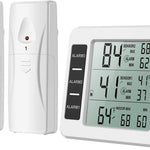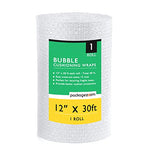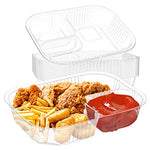You have no items in your shopping cart.
As food safety remains a paramount concern, proper hygiene practices play a critical role in preventing foodborne illnesses. Among these practices, the use of gloves by food workers has become a standard preventive measure. Understanding when food workers are required to wear gloves is crucial for maintaining high standards of cleanliness and minimizing the risk of contamination. In this article, we will delve into the various scenarios and settings in which gloves are mandatory, ensuring that food establishments, whether commercial or domestic, adhere to the best practices. Let's explore when food workers are required to wear gloves and gain valuable insights into this essential aspect of food handling.
Click picture to view price on Amazon
When Are Food Workers Required to Wear Gloves?
In this section, we will explore the primary situations when food workers are required to wear gloves and the reasons behind each requirement.
1. Food Preparation and Handling
When food workers are involved in the preparation and handling of ready-to-eat foods, they must wear gloves. This includes any activity that involves direct contact with cooked, ready-to-eat, or "ready-to-serve" food items. Whether it's assembling sandwiches, handling pastries, or packaging salads, gloves are essential to prevent potential contamination from the workers' hands.
Insight: Wearing gloves during food preparation reduces the risk of transferring harmful pathogens from the food workers' hands to the consumables.
2. Handling Raw Foods
When food workers handle raw meats, poultry, fish, or any other raw ingredients, gloves are mandatory. Raw foods can carry harmful bacteria and should not come into direct contact with hands to avoid cross-contamination.
Insight: Proper glove usage when handling raw foods helps prevent cross-contamination and ensures the safety of the final dishes.
3. Dealing with Allergens
In cases where allergens are present in the food establishment, food workers should wear gloves to prevent allergen transfer. This is especially critical for establishments that handle various allergenic ingredients.
Insight: Wearing gloves when working with allergens helps protect sensitive individuals from potential allergic reactions due to cross-contact.
4. Open Wounds, Cuts, or Skin Conditions
Food workers with open wounds, cuts, or certain skin conditions should always wear gloves. This measure is essential to prevent any potential pathogens from entering the food, ensuring the safety of consumers.
Insight: Encouraging workers to wear gloves when they have open wounds or skin issues prioritizes food safety and maintains the establishment's reputation.
5. Cleaning and Sanitizing
During cleaning and sanitizing procedures, food workers should use disposable gloves. This practice prevents direct contact with cleaning chemicals and ensures the safety of the workers' skin.
Insight: Using gloves during cleaning procedures protects food workers from skin irritations caused by harsh cleaning agents.
6. Serving Ready-to-Eat Food
When serving ready-to-eat food, gloves are essential to avoid direct contact between the food and the server's hands. This requirement applies to buffet-style setups, catering events, and even food trucks.
Insight: Wearing gloves during food service maintains the integrity of ready-to-eat meals and demonstrates the establishment's commitment to hygiene.
7. Food Sampling and Tasting
In situations where food sampling or tasting occurs, food workers must wear gloves. This is especially critical at events where multiple individuals interact with the same food items.
Insight: Gloves protect the food samples from potential contaminants introduced by numerous samplers.
Frequently Asked Questions (FAQs)
In this section, we will address some commonly asked questions regarding when food workers are required to wear gloves.
Q: Are there exceptions to wearing gloves for food workers?
A: While gloves are vital for various food handling tasks, certain situations do not require their use. For example, when washing produce, gloves are unnecessary, as long as the workers wash their hands thoroughly before and after the task. However, it is always best to consult local health regulations for specific guidelines.
Q: Can food workers reuse gloves throughout the day?
A: No, gloves should not be reused throughout the day, especially when handling different food items. Gloves are meant for single-use only and should be changed regularly, following each different task or handling raw foods.
Q: Do all food workers need to wear gloves, regardless of their role?
A: In most cases, yes. Regardless of their specific roles, any food worker involved in food preparation, handling, or serving should wear gloves to ensure food safety and prevent contamination.
Q: How often should food workers change their gloves?
A: Food workers should change gloves whenever they switch tasks, handle raw foods, touch their face or hair, or after any activity that may cause contamination. Regular glove changes are essential to maintain food safety.
Q: Are there alternatives to gloves for certain food handling tasks?
A: Yes, in some cases, utensils like tongs or scoops may be used instead of gloves for certain food handling tasks. However, gloves remain the most common and effective way to prevent direct hand contact with food.
Q: Can hand sanitizers replace gloves for food workers?
A: Hand sanitizers should not replace gloves when handling food. While sanitizers are useful for maintaining hand hygiene, they do not offer the same level of protection against contamination as gloves.
Conclusion
Proper glove usage is a fundamental aspect of maintaining food safety and hygiene in any food establishment. Food workers must wear gloves when handling ready-to-eat foods, dealing with raw ingredients, working with allergens, and during cleaning and serving procedures. Wearing gloves not only safeguards consumers but also demonstrates the establishment's commitment to providing safe and quality food. By following these guidelines and best practices, food workers can ensure a healthier and safer dining experience for everyone.











